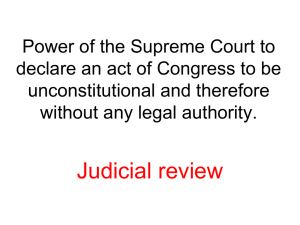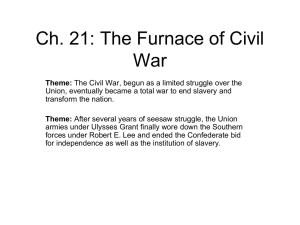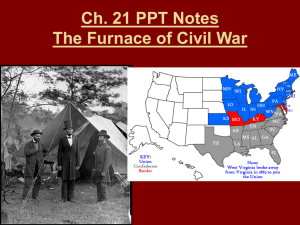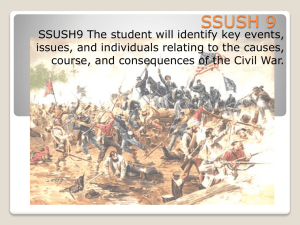Union
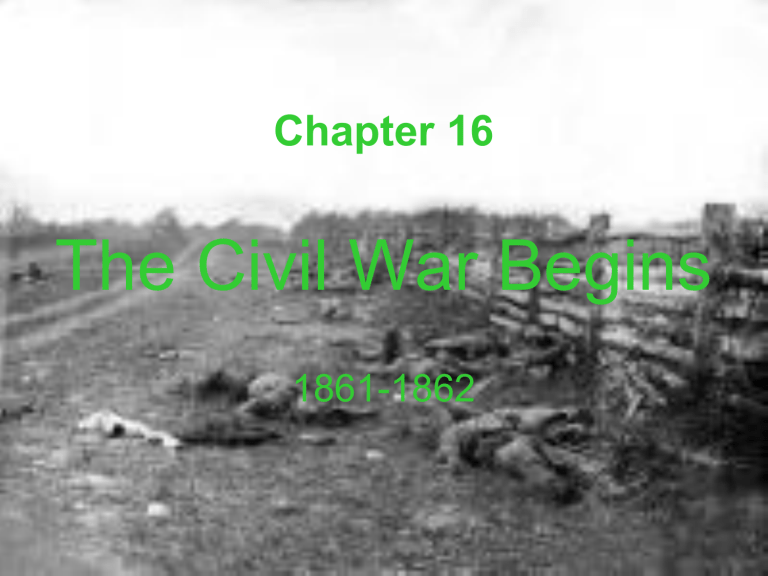
Chapter 16
The Civil War Begins
1861-1862
I. Find Out
A.
How fighting began at Fort Sumter
B.
The strengths and weaknesses of each side
C.
Each side’s basic strategy
D.
The results of the first battle of Bull Run
Fort Sumter was located in the harbor of
Charleston, SC. under the command of Major
Robert Anderson.
Lincoln decided to send supplies rather than give it to the
Confederates.
II.
First Shots at Fort Sumter
A.
Southern states began seizing federal forts inside borders once they seceded
B.
Lincoln had to decide what to do with those that remained under federal control
C.
Fort Sumter was located in the harbor of Charleston, SC
D.
Under command of Major Robert
Anderson
E.
Running out of supplies
E. Lincoln risked war if he supplied Fort Sumter
F. If he ordered the troops to leave, he was giving in to the rebels
G. Lincoln decided to send supplies
H. April 12, 1861, at 4:30 a.m. shore guns opened fire on the island fort i. Fired on the fort for 34 hours j. Major Anderson surrendered k. Civil War had begun
The Bombardment of Fort Sumter
Fort Sumter Under Attack
Although there were no casualties during the bombardment, one
Union artillerist was killed and three wounded (one mortally) when a cannon exploded prematurely when firing a salute during the evacuation.
F.Lincoln Calls Out the
Militia
1. Asked for 75,000 militiamen for 90 days
2. Citizens of North responded with enthusiasm
3.
Robert E. Lee resigned from Union to fight for the Confederacy
Robert E. Lee of Virginia could not turn his back on his native Virginia once the war began.
G. Choosing Sides
1. Four original border states play key role in outcome of war
2.Delaware, Maryland,
Kentucky,& Missouri
H. Strengths of North
1. Union has 22 million in population
2. South has 9 million (3.5 M in slaves)
3. 85% of factories in North
4. North has double the railroad mileage
5. Almost all naval power and shipyards in North
6. Great leader in Abraham Lincoln
I.
Southern Strengths
1. Able generals like Robert E. Lee
2. Fighting a defensive war
3. Defending their homeland
J. The Confederate Strategy
1. Take a defensive position
2. King Cotton a. Hoped to win foreign support through cotton trade b. Withheld cotton from market c. Wanted France and Britain to aid cause d. Surplus in 1861 ruined plan e. Began to take offensive and win big victories
K. The Union Strategy
1. Bring Southern states back into Union
2. Anaconda plan a. Smother South’s economy b. Blockade southern coastline c. Gain control of the Mississippi River
The goal of the Anaconda Plan was to cut the South in half by blockading Southern ports and capturing the
Mississippi River. This plan was devised by General
Winfield Scott.
I.
First Battle of Bull Run
1. Confederate troops stationed at
Manassas, Va., SW of Washington, D.C.
2. July 21, 1861, Union forces led by
General Irvin McDowell clashed with
Confederate troops led by Gen. Pierre
Beauregard
3. Little creek was called Bull Run where battle was held
4. Stonewall Jackson’s nickname
5. “Rebel Yell”
6. First major battle of war
Bull Run was a small creek that was located north of
Manassas, Virginia, a railway center southwest of
Washington, D.C. On July 21,
1861, Union and Confederate troops clashed in the first real battle of the Civil War.
The battle turned into a convincing Confederate victory, and General Thomas
“Stonewall” Jackson received his famous nickname for standing tall
“like a stonewall” in the face of the battle.
After standing their ground in the face of battle during the Union charge, the Rebels soon
Received 9,000 reinforcements which turned the tide of the battle their way. The disorganized
Union retreat back to Washington meant defeat for the Union troops.
Stonewall Jackson standing tall during the first Battle of Bull Run.
A. Summarizing As you read about the outbreak of The Civil War, summarize the strengths and weaknesses of each side at the time the war was declared.
1. What advantages did the Union have?
•The Union had a larger population of 22 million compared to the South’s 9 million of which 3.5 million were slaves.
•The Union owned 85% of the nation’s factories
•The Union had twice the railroad mileage as the South
•The Union controlled almost all of the naval power
•The North had a strong leader in Abraham Lincoln
2. What advantages did the Confederacy have?
•The South had able generals like Robert E. Lee
•The South was fighting a defensive war which would stretch the North’s supply lines
•Soldiers in the South were defending their own homes
B. Summarizing As you read about the early days of the war, summarize the
Confederate strategy and the Union strategy.
1. What was the South’s strategy?
The South’s strategy was to take a defensive position and not try to conquer the North.
They wanted to draw France and Britain into the war by withholding cotton from the
European market.
Later in the war, the South became offensive and tried for big victories to destroy
Northern moral.
2. What was the North’s strategy?
The Anaconda plan called for a blockade on the South’s coastline to keep goods and people from getting in or out of the South. The North then wanted to capture the
Mississippi River and split the South in half.
C. Categorizing Fill in the chart below with information about two early battles of the
Civil War.
1. Fort Sumter
2. First Battle of Bull
Run
Leaders
Major Robert
Anderson for the
North
Abraham Lincoln-
North
Gen. Pierre
Beauregard-South
North- Gen. Irvan
McDowell
South- Gen. Pierre
Beauregard and
Gen. Thomas
“Stonewall” Jackson
Outcome of the Battle
The South bombarded the fort for over 34 hours.
Eventually, Major
Anderson surrendered the fort although no one was killed in the attack.
Huge Confederate victory as the Union army was overrun by Confederate lines
Important Facts
First Battle of the
Civil War
No casualties during bombardment
Jackson got his nickname
Shocked the North into realizing it could be a long war
D. Summarizing On the back of this paper, briefly explain the Anaconda Plan and King Cotton.
• Anaconda PlanThe Anaconda Plan was the North’s strategy to try and squeeze the South by blockading the South’s ports and capturing the
Mississippi River which would cut the South in half
• King Cotton- Southern cotton was important in the world market because the South grew most of the cotton for Europe’s textile mills.
II.
Life in the Army
A. Find Out
1.
Who joined the armies
2.
Describe military training and supplies of the era
3.
Summarize the hardships of army life
4.
Identify changes in military technology
The North expected a quick victory when they clashed with
Confederates at the First Battle of Bull Run on July 21, 1861. Afterwards, the North realized that the war was not going to be as quick as they thought.
B. Those Who Fought
1. Majority between 18-30
2. Farmers were largest group
3. Many immigrants served
4. African Americans
5. Native Americans
6. 2 million served in Union
7. Fewer than 1 million in Confederacy
C. Turning Civilians into Soldiers
1. Army camps looked like a sea of canvas tents
2. Grouped by company with 2-20 men in a tent
3. Men elected their company officers
4. Followed routine after roll call and breakfast a. Drills b. Guard duty, cut wood, dug trenches, cleaned up the camp
Civil War camps often looked like a sea of canvas tents. Life in the camps was often difficult and demanding.
Soldiers take time for a picture during a lull in the fighting.
Not all their time was spent fighting. This is a company of soldiers.
5. Uniforms a. Union-blue b. Confederatesgray or yellowishbrown c. Both sides faced shortages of uniforms that fit properly and often traded d. Confederate troops often marched over frozen ground with no shoes
6. Union clothing often poor quality
7. Confederates differed from state to state
8. Took clothes off the dead soldiers
9. Food consisted of beef or salt pork, flour, vegetables, and coffee but supply trains often couldn’t reach battlefield and soldiers went hungry
D. Hardships of Army Life
1. Camps were unsanitary and smelled
2. Soldiers were filthy-lice and fleas
3. Poor hygiene resulted in widespread sickness
4. Unclean instruments of doctors caused disease
E. Changes in Military
Technology
1. Rifles with grooved barrels
2. Rifles with mini é balls
3. Ironclad ships
• Both sides
• Wooden ships covered in iron
Lead mini é balls changed battle field tactics because they could shoot more accurately than round balls.
When they entered the body they flattened out which caused more serious damage to the body. More soldiers died from infections after being shot than by the wounds themselves.
USS Monitor (Union) and the Merrimack (Virginia) squared off in the first ironclad battle on March 9, 1862, off the coast of Virginia. The battle ended in a stalemate.
A. Taking Notes As you read about the lives of ordinary soldiers, make notes about daily life in the military during the Civil War.
1. Who fought
Most soldiers were between 18-30 but some were younger and some older. Farmers make up the largest group. Immigrants, such as
Germans and Irish, served. At the beginning neither the North nor the South allowed African Americans to serve, but eventually they did serve for the North. About 2 million served for the North and 1 million for the South. Most were volunteers.
2. How they were trained
A typical camp looked like a sea of canvass tents, which were grouped by company and held 2-20 men. A soldiers followed a set schedule. After breakfast and roll call, soldiers had drill sessions. In between drills and meals, soldiers performed guard duty, cut wood for camp fires, dug trenches for latrines, and cleaned up the camp.
3. What hardships they endured
Soldiers were often wet, muddy, or cold from marching outdoors and living in crude shelters. Many camps were unsanitary and smelled of odors from the garbage and latrines. Soldiers were filthy, and their bodies and clothes became infested with lice and fleas.
Sickness was widespread, such as chronic diarrhea or other intestinal disorders.
4. How new technology affected soldiers
Rifles using mini é balls could shoot from a greater distance and with more accuracy. Ironclad ships were a vast improvement over wooden ships.
B. Summarizing On the back of this paper, briefly identify each of the following.
Monitor and Merrimack- In the first ironclad battle, the Confederate Virginia (originally named the Merrimack) battled the Union Monitor off the coast of Virginia in March of 1862. After hammering away for about four hours,
The battle ended in a draw. rifle- a gun with a grooved barrel that allows the bullet to spin through the air, giving it greater accuracy and distance.
mini é ball- a bullet with a hollow base that expands upon firing to fit the grooves of the barrel. Rifles with
Minié balls could shoot farther and more accurately than old-fashioned muskets.
III. No End in Sight
A. Find Out
1. Analyze the Union victories in the
South
2. Explain how the fall of New Orleans helped the Union
3. Analyze Lee’s victories in the East and his decision to invade the North
4. Describe the Battle of Antietam
B.
Union Victories in the West
1.
February of 1862
2.
Ulysses S. Grant moves on Tennessee
3.
Uses ironclad gunboats
4.
Captures two Confederate river forts a. Fort Henry on the Tennessee River b. Fort Donelson on the Cumberland
5.
Opened up river highway into the heart of the South
6. Grant’s army moved onto Nashville
By taking Fort Henry and Fort Donelson, Grant opened the South for
Union victories through river travel.
C. The Battle of Shiloh (Place of Peace)
1.
Confederate commander Albert S.
Johnston moved troops to Corinth, MS
2.
Grant moved his troops to Pittsburg
Landing in Tennessee
3.
Johnston’s army surprised Grant’s troops at the Battle of Shiloh in
Tennessee
4.
Fiercest fighting of war
5.
Heavy casualties a. 13,000 Union b. 11,000 Confederate
6. Lincoln says he can’t replace Grant
7.
Considered a Union victory
D. The Fall of New Orleans
1.
April 25, 1862, Union fleet led by
David Farragut captured New Orleans
2.
Largest city in the South
3.
Rebel gunboats tried to ram Union warships, sinking one
4.
Dodge burning rafts
5.
Left only 150 miles of Mississippi in
Confederate hands
After capturing New Orleans in 1862, only 150 miles of the Mississippi remained in Union hands.
E. Lee Claims Victories in the East
1. Spring 1862 Gen. McClellan (Union) decides to capture Richmond
2. Took troops in stretch of land between
York and James Rivers, a few miles within Richmond
3. Jeb Stuart and Calvary surveys Union army
4. Robert E. Lee attacked McClellan’s army
5. Seven Days’ Battles Confederate victory
6. June 25 to July 1, 1862
7. Forced McClellan to retreat and saved
Richmond
8. 2 nd Battle of Bull Run in August, 1862
9. Another Confederate victory
F. Lee Invades the North
1. Crucial time with North at low point
2. Crossed Potomac and invaded Maryland in early September of 1862
3. Hoped victory in the North might get
Lincoln to talk peace
4. Might convince France and Britain to aid South if they won a victory
G. Bloody Antietam
1. Union soldier finds battle plans
2. Gave McClellan a chance to stop Lee
3. McClellan moved slowly again
4. Armies clashed on September 17,1862
5. Sharpsburg, MD, at Antietam Creek
6. Bloodiest single day battle in American history
7. Neither side gained much ground
8. 25,000 casualties
9. Lee lost 1/3 of fighting force and withdrew to Virginia
10. McClellan didn’t follow and was fired
7 Facts About Antietam
• Antietam was the bloodiest single-day battle in American history, with about 23,000 casualties.
• This was a two to one battle with Robert E. Lee’s Army of Northern Virginia having approximately 45,00 troops to Union Army Maj. Gen. George B. McClellan’s 90,000 troops.
• General Lee’s battle plans were known in advance. Two Union soldiers (Corporal
Barton W. Mitchell and First Sergeant John M. Bloss of the 27th Indiana Volunteer
Infantry) discovered a mislaid copy of Lee’s detailed battle plans-Special Order 191wrapped around three cigars. McClellan delayed acting on this knowledge 18 hours, thus losing the opportunity laid at his feet.
• McClellen was a poor leader during this battle, issuing isolated commands to each unit, causing chaos during the execution of said plans.
• The battle began at 5:30 AM (Dawn) on September 17, 1862, and lasted until 5:30
PM that day.
• The Union had 12,401 casualties with 2,108 dead. Confederate casualties were
10,318 with 1,546 dead.
• President Lincoln was disappointed in McClellan’s performance. He believed that
McClellan’s cautious and poorly coordinated actions in the field had forced the battle to a draw rather than a crippling Confederate defeat. Lincoln relieved McClellan of his command of the Army of the Potomac on November 7 after repeated demands that he do his job effectively and bravely, effectively ending the general’s military career.
Lincoln was so fed up with McClellan failing to go on the offensive that he fired him after the Battle of Antietam when McClellan didn’t follow Lee’s army into Virginia.
A. Summarizing As you read about the ongoing Civil War, summarize the victories won by each side.
1. What victories did the Union win?
In the West General Grant used ironclad boats to capture Fort Henry on the Tennessee River and
Fort Donelson on the Cumberland. Soon after, Nashville was captured. The Confederates retreated to Corinth, MS, and surprised Union forces near the Shiloh Church. The Union won but both sides suffered heavy casualties. In the spring of 1862, Union forces captured New Orleans.
Sept. 17, 1862-Battle of Antietam
2. What victories did the Confederacy win?
In the spring of 1862, General McClellan made a move to capture Richmond. The Seven Days’
Battle ended with a Confederate victory between June 25-July 1 of 1862. The South won the
Second Battle of Bull Run, ending the Union threat in Virginia. General Lee decided to invade
Maryland in September of 1862. The two sides met at Antietam Creek without a clear victory but heavy casualties on both sides.
1. Shiloh
2. Antietam
Head of
Union Forces
General Grant
General William
Tecumseh Sherman
Head of
Confederate Forces
General Albert S.
Johnston
General Pierre
Beauregard
Outcome of the Battle
Union forces won after a surprise attack. Both sides suffered huge casualties.
General George
McClellan
General Robert E.
Lee
Important Facts
13,000 Union casualties
11,000 Confederate casualties
Neither side won a clear victory. It was the bloodiest single day battle in the history of the U.S
Union brought up fresh troops during night time thunderstorm
25,000 dead or wounded
Lee lost 1/3 of his force
McClellan failed to follow Lee
C. Finding Main Ideas On the back of this paper, briefly explain the Seven Days’
Battles and who Ulysses S. Grant was.
Seven Days’ Battles- a week long battle fought between June 25 and July 1, 1862. The Confederate army suffered heavier losses but forced McClellan to retreat
Ulysses S. Grant- a Union general who headed the army in the western theater of the war. Grant had failed at many things in civilian life but turned out to be a brilliant general who had one simple strategy: “Find out where your enemy is, get at him as soon as you can, strike at him as hard as you can, and keep moving on.”



